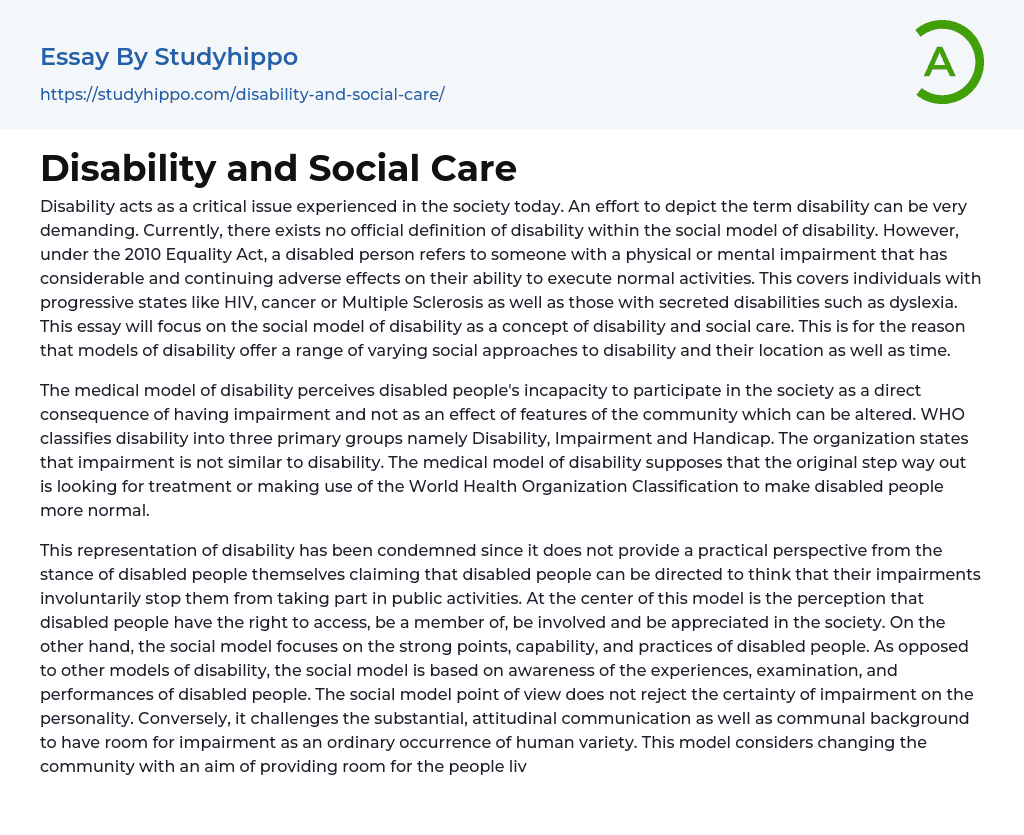Currently, disability is a crucial concern that society is experiencing.
The social model of disability is challenging to precisely define as it does not have an official definition. Nevertheless, according to the 2010 Equality Act, a disabled person is someone whose physical or mental impairment continuously and significantly hinders their ability to perform daily tasks. This encompasses individuals with progressive conditions such as HIV, cancer, or Multiple Sclerosis, as well as those with concealed disabilities like dyslexia. The essay will primarily examine the link between the social model of disability and disability in social care.
Various social approaches to disability exist due to different models of disability in various locations and time periods. The medical model of disability perceives the inability of disabled individuals to participate in society as a direct consequence of their impairments, rather than being influenced by changeable aspects of the community.
...The World Health Organization (WHO) classifies disability into three primary categories: Disability, Impairment, and Handicap. According to WHO, impairment should not be synonymous with disability. The medical model proposes that seeking treatment or utilizing the WHO Classification can help normalize disabled individuals.
However, this portrayal has faced criticism for lacking a practical perspective from the standpoint of disabled people themselves. Critics argue that this depiction may lead disabled individuals to believe that their impairments automatically hinder their involvement in public activities.
The central concept of this model is that individuals with disabilities should have the right to access, participate in, and be respected members of society. Moreover, the social model highlights the abilities, skills, and contributions of disabled people. Unlike other disability models, the social model acknowledges and values the experiences and accomplishments of disable
individuals. It is crucial to recognize that the social model does not disregard the presence of disabilities in individuals.
This model offers a unique viewpoint on disability, perceiving it as a typical aspect of human diversity. It supports inclusive communication and social settings that recognize disability as inherent. Rather than segregating individuals with disabilities, the model urges society to embrace and adapt for them. It advocates for equal rights for people with disabilities, allowing their complete engagement in all facets of life.
- Addiction essays
- Anatomy and Physiology essays
- Biodegradation essays
- Cancer essays
- Dental Care essays
- Disability essays
- Disease essays
- Disorders essays
- Health Care essays
- Infectious Disease essays
- Inquiry essays
- Intelligence Quotient essays
- Lung Cancer essays
- Medicine essays
- Neurology essays
- Nutrition essays
- Olfaction essays
- Physical Exercise essays
- Public Health essays
- Sex essays
- Women's Health essays
- World health organization essays
- Adhd essays
- Antisocial Personality Disorder essays
- Anxiety essays
- Bipolar Disorder essays
- Depression essays
- Depression And Anxiety essays
- Dyslexia essays
- Learning Disability essays
- Major Depressive Disorder essays
- Mental Disorder essays
- Mental Illness essays
- Psychosis essays
- Schizophrenia essays
- Stress essays
- Suicide essays




